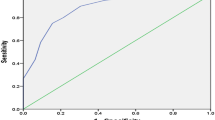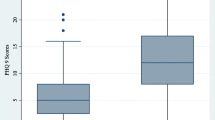Abstract
Common mental disorders are highly prevalent in emergency centre (EC) patients, yet few brief screening tools have been validated for low- and middle-income country (LMIC) ECs. This study explored the psychometric properties of the SRQ-20 screening tool in South African ECs using the Mini Neuropsychiatric Interview (MINI) as the gold standard comparison tool. Patients (n = 200) from two ECs in Cape Town, South Africa were interviewed using the SRQ-20 and the MINI. Internal consistency, screening properties and factorial validity were examined. The SRQ-20 was effective in identifying participants with major depression, anxiety disorders or suicidality and displayed good internal consistency. The optimal cutoff scores were 4/5 and 6/7 for men and women respectively. The factor structure differed by gender. The SRQ-20 is a useful tool for EC settings in South Africa and holds promise for task-shifted approaches to decreasing the LMIC burden of mental disorders.



Similar content being viewed by others
References
Beck, A. T., & Steer, R. A. (1993). Beck depression inventory manual. San Antonio: Psychological Corporation.
Becker, J., Dell, A., Jenkins, L., et al. (2012). Reasons why patients with primary health care problems access a secondary hospital emergency centre. South African Medical Journal, 102, 800–801.
Beusenberg, M., & Orley, J. (1994). A user’s guide to the self reporting questionnaire. Geneva: Division of Mental Health, World Health Organization.
Bhagwanjee, A., Parekh, A., Paruk, Z., et al. (1998). Prevalence of minor psychiatric disorders in an adult African rural community in South Africa. Psychological Medicine, 28, 1137–1147.
Booth, B., Walton, M., Barry, K., et al. (2011). Substance use, depression, and mental health functioning in patients seeking acute medical care in an inner-city ED. Journal of Behavioral Health Services and Research, 38, 358–372.
Bower, P., Gilbody, S., Richards, D., et al. (2006). Collaborative care for depression in primary care: making sense of a complex intervention: systematic review and meta-regression. The British Journal of Psychiatry, 189, 484–493.
Cattell, R. B. (1966). The scree test for the number of factors. Multivariate Behavioral Research, 1, 245–276.
Chen, S., Zhao, G., Li, L., et al. (2009). Psychometric properties of the Chinese version of the self-reporting questionnaire 20 (SRQ-20) in community settings. International Journal of Social Psychiatry, 55, 538–547.
Cherian, V., Peltzer, K., & Cherian, L. (1998). The factor structure of the self report questionnaire (SRQ20) in South Africa. East African Medical Journal, 75, 654–656.
Cherpitel, C. J. (2007). Alcohol and injuries: a review of international emergency room studies since 1995. Drug and Alcohol Review, 26, 201–214.
Chipimo, P. J., & Fylkesnes, K. (2010). Comparative validity of screening instruments for mental distress in zambia. Clin Practice Epidemiology Mental Health, 6, 4–15.
Cunningham, R. M., Murray, R., Walton, M. A., et al. (2009). Prevalence of past year assault among inner-city emergency department patients. Annals of Emergency Medicine, 53, 814–823.e815.
Dale, J., Green, J., Reid, F., et al. (1995). Primary care in the accident and emergency department: I. Prospective identification of patients. BMJ (Clin Res Ed), 311, 423–426.
Demyttenaere, K., Bruffaerts, R., Posada-Villa, J., et al. (2004). Prevalence, severity, and unmet need for treatment of mental disorders in the World Health Organization World Mental Health Surveys. JAMA, 291, 2581–2590.
Giang, K. B., Allebeck, P., Kullgren, G., et al. (2006). The Vietnamese version of the self reporting questionnaire 20 (SRQ-20) in detecting mental disorders in rural Vietnam: a validation study. International Journal of Social Psychiatry, 52, 175–184.
Gonçalves, D. M., Stein, A. T., & Kapczinski, F. (2008). Avaliação de desempenho do self-reporting questionnaire Como instrumento de rastreamento psiquiátrico: um estudo comparativo com o structured clinical interview for DSM-IV-TR. Cadernos de Saúde Pública, 24, 380–390.
Grant, B. F., Stinson, F. S., Dawson, D. A., et al. (2004). Prevalence and co-occurrence of substance use disorders and independentmood and anxiety disorders: results from the national epidemiologic survey on alcohol and relatedconditions. Archives of General Psychiatry, 61, 807–816.
Guttman, L. (1954). Some necessary conditions for common factor analysis. Psychometrika, 19, 149–161.
Harding, T. W., De Arango, V., Baltazar, J., et al. (1980). Mental disorders in primary health care: a study of their frequency and diagnosis in four developing countries. Psychological Medicine, 10, 231–241.
Harpham, T., Reichenheim, M., Oser, R., et al. (2003). Measuring mental health in a cost-effective manner. Health Policy and Planning, 18, 344–349.
Hodkinson, P. W., & Wallis, L. A. (2009). Cross-sectional survey of patients presenting to a South African urban emergency centre. Emergency Medicine Journal, 26, 635–640.
Iacoponi, E., & Jair de Jesus, M. (1989). Reliability and factor structure of the Portuguese version of self-reporting questionnaire. International Journal of Social Psychiatry, 35, 213–222.
Kaiser, H. F. (1960). The application of electronic computers to factor analysis. Educational and Psychological Measurement, 20, 141–151.
Kakuma, R., Minas, H., van Ginneken, N., et al. (2011). Human resources for mental health care: current situation and strategies for action. The Lancet, 378, 1654–1663.
Kessler, R., Andrews, G., Colpe, L. J., et al. (2002). Short screening scales to monitor population prevalences and trends in non-specific psychological distress. Psychological Medicine, 32, 959–976.
Kessler, R. C., Angermeyer, M., Anthony, J. C., et al. (2007). Lifetime prevalence and age-of-onset distributions of mental disorders in the World Health Organization’s World Mental Health Survey Initiative. World Psychiatry, 6, 168–176.
Kohn, R., Saxena, S., Levav, I., et al. (2004). The treatment gap in mental health care. Bulletin of the World Health Organization, 82, 858–866.
Mari, J. J., & Williams, P. (1986). A validity study of a psychiatric screening questionnaire (SRQ-20) in primary care in the city of Sao Paulo. The British Journal of Psychiatry, 148, 23–26.
Parry, C. D. H., Pluddemann, A., Donson, H., et al. (2005). Cannabis and other drug use among trauma patients in three South African cities, 1999–2001: original article. 95:429–432.
Patel, V., Araya, R., Chowdhary, N., et al. (2008). Detecting common mental disorders in primary care in India: a comparison of five screening questionnaires. Psychological Medicine, 38, 221–228.
Plüddemann, A., Parry, C., Donson, H., et al. (2004). Alcohol use and trauma in Cape Town, Durban and Port Elizabeth, South Africa: 1999–2001. Injury Control and Safety Promotion, 11, 265–267.
Richmond, T. S., Hollander, J. E., Ackerson, T. H., et al. (2007). Psychiatric disorders in patients presenting to the emergency department for minor injury. Nursing Research, 56, 275–282.
Rumble, S., Swartz, L., Parry, C., et al. (1996). Prevalence of psychiatric morbidity in the adult population of a rural South African village. Psychological Medicine, 26, 997–1007.
Saliou, V., Fichelle, A., McLoughlin, M., et al. (2005). Psychiatric disorders among patients admitted to a French medical emergency service. General Hospital Psychiatry, 27, 263–268.
Scholte, W., Verduin, F., van Lammeren, A., et al. (2011a). Psychometric properties and longitudinal validation of the self-reporting questionnaire (SRQ-20) in a Rwandan community setting: a validation study. BMC Medical Research Methodology, 11, 116.
Scholte, W. F., Verduin, F., van Lammeren, A., et al. (2011b). Psychometric properties and longitudinal validation of the self-reporting questionnaire (SRQ-20) in a Rwandan community setting: a validation study. BMC Medical Research Methodology, 11, 116.
Sen, B. (1987). An analysis of the nature of depressive phenomena in primary care using multivariate statistical techniques. Acta Psychiatrica Scandinavica, 76, 28–32.
Sheehan, D. V., Lecrubier, Y., Sheehan, K. H., et al. (1998). The Mini-International Neuropsychiatric Interview (M.I.N.I.): the development and validation of a structured diagnostic psychiatric interview for DSM-IV and ICD-10. Journal of Clinical Psychiatry, 59(Suppl 20), 22–33. quiz 34–57.
Sorsdahl, K., Myers, B., Ward, C., et al. (2013). Screening and brief interventions for substance use in emergency departments in the Western Cape province of South Africa: Views of health care professionals. International Journal of Injury Control and Safety Promotion.
Stevens, J. P. (2002). Applied multivariate statistics for the social sciences (4th ed.). Hillsdale: Erlbaum.
Stratton, K. J., Aggen, S. H., Richardson, L. K., et al. (2013). Evaluation of the psychometric properties of the self-reporting questionnaire (SRQ-20) in a sample of Vietnamese adults. Comprehensive Psychiatry, 54, 398–405.
Thom, R., Zwi, R., & Reinach, S. (1993). The prevalence of psychiatric disorders at a primary care clinic in Soweto, Johannesburg. South African Medical Journal, 83, 653–655.
Tuan, T., Harpham, T., & Huong, N. T. (2004). Validity and reliability of the self-reporting questionnaire 20 items in Vietnam. Hong Kong Journal of Psychiatry, 14, 15–18.
Ventevogel, P., De Vries, G., Scholte, W. F., et al. (2007). Properties of the Hopkins symptom checklist-25 (HSCL-25) and the self-reporting questionnaire (SRQ-20) as screening instruments used in primary care in Afghanistan. Social Psychiatry and Psychiatric Epidemiology, 42, 328–335.
World Health Organization. (2008). The global burden of disease: 2004 update. Geneva: World Health Organization.
Zwick, W. R., & Velicer, W. F. (1986). Comparion of five rules for determining the number of factors to retain. Psychological Bulletin, 99, 432–442.
Acknowledgments
This study was funded by Phodiso Program, Fogarty International (grant number 1 D43 TW007278). The financial assistance of the National Research Foundation (NRF) towards this research is hereby acknowledged. Opinions expressed and conclusions arrived at, are those of the author and are not necessarily attributed to the NRF.
Informed consent
All procedures followed were in accordance with the ethical standards of the responsible committee on human experimentation (institutional and national) and with the Helsinki Declaration of 1975, as revised in 2000 (5). Informed consent was obtained from all patients for being included in the study.
Conflicts of interest
The authors declare that they have no conflicts of interest.
Author information
Authors and Affiliations
Corresponding author
Rights and permissions
About this article
Cite this article
van der Westhuizen, C., Wyatt, G., Williams, J.K. et al. Validation of the Self Reporting Questionnaire 20-Item (SRQ-20) for Use in a Low- and Middle-Income Country Emergency Centre Setting. Int J Ment Health Addiction 14, 37–48 (2016). https://doi.org/10.1007/s11469-015-9566-x
Published:
Issue Date:
DOI: https://doi.org/10.1007/s11469-015-9566-x




